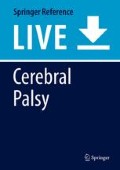Abstract
Children with severe cerebral palsy frequently develop scoliosis and other spinal deformities that require spinal fusion for correction. Because many of the children who develop spinal deformities have very severe neurologic deficits, the complication risks during and after the spinal fusion is high. Children with severe cerebral palsy who are not having aggressive nutritional management through gastrostomy tubes may have nutritional deficits. If these nutritional deficits are severe, the ability to tolerate a large surgical procedure and with a large wound is decreased. Management of the nutritional deficit may be with preoperative increased nutrition or the insertion of a gastrostomy or nasogastric tube. Alternatively, this can be managed with diligent attention to immediate postoperative nutritional intake. This acute postoperative nutritional intake may require insertion of a nasogastric or nasal jejunostomy tube for early feeding. In some rare cases, central venous hyperalimentation will be required. Other complications include high blood loss intraoperative requiring a diligent attention to a blood replacement. There are multiple other complications that need to be monitored such as sepsis, pancreatitis, cholangitis, and urinary tract infections in the immediate postoperative period. Gastroesophageal reflux is another common problem that needs to be medically managed before and during the surgical recovery.
References
Del Beccaro MA, McLaughlin JF, Polage DL (1991) Severe gastric distension in seven patients with cerebral palsy. Dev Med Child Neurol 33:912–916
Boachie-Adjei O, Lonstein JE, Winter RB, Koop S, vanden Brink K, Denis F (1989) Management of neuromuscular spinal deformities with Luque segmental instrumentation. Joint Surg Am 71:548–562
Bohmer CJ, Niezen-de Boer MC, Klinkenberg-Knol EC, Deville WL, Nadorp JH, Meuwissen SG (1999) The prevalence of gastroesophageal reflux disease in institutionalized intellectually disabled individuals. Am J Gastroenterol 94:804–810
Borkhuu B, Nagaraju D, Miller F, Moamed Ali MH, Pressel D, Adelizzi-Delany J, Miccolis M, Dabney K, Holmes L Jr (2009) Prevalence and risk factors in postoperative pancreatitis after spine fusion in patients with cerebral palsy. J Pediatr Orthop 29:256–262
Chaudhry MS (2012) Intracranial hypotension caused by dural-pleural fistula. J Neuroimaging 22:208–209
Chidambaran V, Gentry C, Ajuba-Iwuji C, Sponsellar PD, Ain M, Lin E, Zhang X, Klaus SA, Njoku DB (2013) A retrospective identification of gastroesophageal reflux disease as a new risk factor for surgical site infection in cerebral palsy patients after spine surgery. Anesth Analg 117:162–168
Dhawale AA, Shah SA, Sponseller PD, Bastrom T, Neiss G, Yorgova P, Newton PO, Yaszay B, Abel MF, Shufflebarger H, Gabos PG, Dabney KW, Miller F (2012) Are antifibrinolytics helpful in decreasing blood loss and transfusions during spinal fusion surgery in children with cerebral palsy scoliosis? Spine (Phila Pa 1976) 37:E549–E555
Duckworth AD, Mitchell MJ, Tsirikos AI (2014) Incidence and risk factors for post-operative complications after scoliosis surgery in patients with Duchenne muscular dystrophy: a comparison with other neuromuscular conditions. Bone Joint J 96-B:943–949
Givon U, Miller F (1999) Shortening of a unit rod protruding into the hip joint: case report and description of a surgical technique. J Spinal Disord 12:74–76
Jevsevar DS, Karlin LI (1993) The relationship between preoperative nutritional status and complications after an operation for scoliosis in patients who have cerebral palsy [published erratum appears in Joint Surg Am; 1256]. Joint Surg Am 75:880–884
Krismer M, Bauer R (1990) The Luque-Galveston operation in the treatment of neuropathic pelvic tilt. Orthopade 19:309–314
Lai LP, Egnor MR, Carrion WV, Haralabatos SS, Wingate MT (2014) Ventricular peritoneal shunt malfunction after operative correction of scoliosis: report of three cases. Spine J 14:e5–e8
Legg J, Davies E, Raich AL, Dettori JR, Sherry N (2014) Surgical correction of scoliosis in children with spastic quadriplegia: benefits, adverse effects, and patient selection. Evid Based Spine Care J 5:38–51
Leichtner AM, Banta JV, Etienne N (1991) Pancreatitis following scoliosis surgery in children and young adults. J Pediatr Orthop 11:594–598
Lipton GE, Miller F, Dabney KW, Altiok H, Bachrach SJ (1999) Factors predicting postoperative complications following spinal fusions in children with cerebral palsy. J Spinal Disord 12:197–205
Master DL, Son-Hing JP, Poe-Kochert C, Armstrong DG, Thompson GH (2011) Risk factors for major complications after surgery for neuromuscular scoliosis. Spine (Phila Pa 1976) 36:564–571
Nectoux E, Giacomelli MC, Karger C, Herbaux B, Clavert JM (2010) Complications of the Luque-Galveston scoliosis correction technique in paediatric cerebral palsy. Orthop Traumatol Surg Res 96:354–361
Nishnianidze T, Bayhan IA, Abousamra O, Sees J, Rogers KJ, Dabney KW, Miller F (2016) Factors predicting postoperative complications following spinal fusions in children with cerebral palsy scoliosis. Eur Spine J 25:627–634
Onimus M, Manzone P, Lornet JM, Laurain JM (1992) Surgical treatment of scoliosis in bed-ridden patients with cerebral palsy. Rev Chir Orthop Reparatrice Appar Mot 78:312–318
Samdani AF, Belin EJ, Bennett JT, Miyanji F, Pahys JM, Shah SA, Newton PO, Betz RR, Cahill PJ, Sponseller PD (2016) Major perioperative complications after spine surgery in patients with cerebral palsy: assessment of risk factors. Eur Spine J 25:795–800
Shapiro G, Green DW, Fatica NS, Boachie-Adjei O (2001) Medical complications in scoliosis surgery. Curr Opin Pediatr 13:36–41
Theroux MC, Corddry DH, Tietz AE, Miller F, Peoples JD, Kettrick RG (1997) A study of desmopressin and blood loss during spinal fusion for neuromuscular scoliosis: a randomized, controlled, double-blinded study. Anesthesiology 87:260–267
Thompson GH, Florentino-Pineda I, Poe-Kochert C, Armstrong DG, Son-Hing J (2008) Role of Amicar in surgery for neuromuscular scoliosis. Spine (Phila Pa 1976) 33:2623–2629
Author information
Authors and Affiliations
Corresponding author
Editor information
Editors and Affiliations
Section Editor information
Rights and permissions
Copyright information
© 2019 Springer Nature Switzerland AG
About this entry
Cite this entry
Miller, F. (2019). Complications of Spine Surgery in Cerebral Palsy. In: Miller, F., Bachrach, S., Lennon, N., O'Neil, M. (eds) Cerebral Palsy. Springer, Cham. https://doi.org/10.1007/978-3-319-50592-3_118-1
Download citation
DOI: https://doi.org/10.1007/978-3-319-50592-3_118-1
Received:
Accepted:
Published:
Publisher Name: Springer, Cham
Print ISBN: 978-3-319-50592-3
Online ISBN: 978-3-319-50592-3
eBook Packages: Springer Reference MedicineReference Module Medicine

